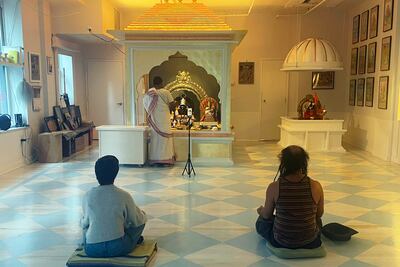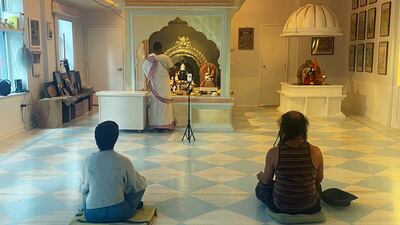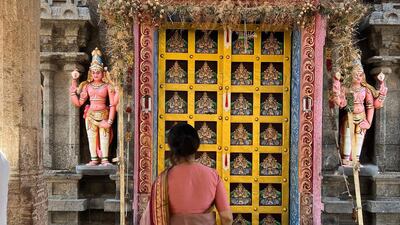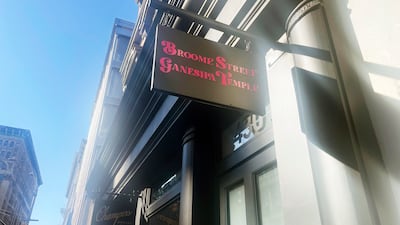On Broome Street, in the heart of Manhattan's fashionable Soho neighbourhood, a Hindu temple dedicated to the elephant-headed deity Ganesha is striving to develop its own "sense of cool". Its location allows it to draw guest teachers, such as spiritual author Deepak Chopra, and famous devotees – or at least influential fans – such as actor Willem Dafoe, who was recently spotted wearing a Broome Street Ganesha T-shirt.
“Here, it’s cool to come to the temple,” says Shruti Bramadesam, the temple’s assistant director. “It’s cool to be spiritual. It’s cool to meditate.”
This week, the 20-year-old temple is celebrating Lord Ganesha in a distinctly New York way, ending the 10-day festival of Ganesh Chaturthi, with a visarjan – a ritual that sends Ganesha home by immersing the clay idol into a body of water – in the Hudson River.
Half yoga studio, half mandir
Founded by yoga teacher Eddie Stern in 2001, the Broome Street Ganesha Temple pitches itself not strictly as a Hindu house of worship, but as a sanctuary where passers-by can find a few minutes of peace amid the chaos of New York.
It’s a role churches and synagogues have long filled in the city’s bustle, but where many of Manhattan’s sacred spaces are ornate monuments to their wealthy patrons of years past, the temple’s natural light and minimalist space – half yoga studio and half mandir – imbibe the Soho vibe.
“The temple is rooted in tradition and history, but also caters to the needs of modern Hindus or people who are spiritual,” Bramadesam says, pointing to deities of Ganesha, as well as Sai Baba, Shiva, Krishna and Radha for busy New Yorkers wanting to drop in to worship.
“It pays homage to the traditional temples of India, but in a cool, modern, New York way,” she adds.
It’s also convenient for urbanites who otherwise would have to trek to Queens, where the largest and oldest Hindu temple in New York City is located.
Temple on TikTok
Bramadesam, who works in marketing as well as consulting at the temple, joined the house of worship in December 2021, bringing with her ideas for a full rebrand. She’s also intent on attracting more Gen Z members.
Thanks to her, this is the only temple with an active following on TikTok, while the temple’s Instagram account hosts puja livestreams.
Hinduism is facing a decline among young people who grew up adhering to their family's religious traditions, as are most institutional faiths operating in the US.
But while young people are not attending services as regularly as their parents, they have not given up on religion entirely. In a recent report on Gen Z Americans, the Springtide Research Institute calls this phenomenon “faith unbundled", suggesting that young people construct their faith “by combining elements such as beliefs, identity, practices and community from a variety of religious and non-religious sources, rather than receiving all these things from a single system”.
Root cause
For many young Hindus, Broome Street is a welcome reminder of the home they left behind.
“This would be a really nice place to come after the work week to decompress and have a moment of meditation,” says researcher and Toronto resident Diya Srinivasan. “It’s ultimately a space where there’s a piece of calm.”
Broome Street isn’t only for the young. Gautam Gupta had not found a temple community in his 23 years in Manhattan, and he found it difficult to get his teenage children interested in attending religious services with him. But when he brought his younger daughter to Broome Street this year, the two stayed for almost two hours.
“It was very peaceful,” Gupta says. “No devices!”
To Gupta, and other members of the Broome Street family, the ultimate goal is to build a community in Manhattan for all, no matter where they are in their spiritual journey. “The bigger the community, the more you feel like you belong to it,” he adds.
Classification of skills
A worker is categorised as skilled by the MOHRE based on nine levels given in the International Standard Classification of Occupations (ISCO) issued by the International Labour Organisation.
A skilled worker would be someone at a professional level (levels 1 – 5) which includes managers, professionals, technicians and associate professionals, clerical support workers, and service and sales workers.
The worker must also have an attested educational certificate higher than secondary or an equivalent certification, and earn a monthly salary of at least Dh4,000.
The%20Little%20Mermaid%20
%3Cp%3E%3Cstrong%3EDirector%3A%3C%2Fstrong%3E%20Rob%20Marshall%3Cbr%3E%3Cstrong%3EStars%3A%20%3C%2Fstrong%3EHalle%20Bailey%2C%20Jonah%20Hauer-King%2C%20Melissa%20McCarthy%2C%20Javier%20Bardem%3Cbr%3E%3Cstrong%3ERating%3A%20%3C%2Fstrong%3E2%2F5%3Cbr%3E%3Cbr%3E%3C%2Fp%3E%0A
The specs
Engine: 3.8-litre, twin-turbo V8
Transmission: eight-speed automatic
Power: 582bhp
Torque: 730Nm
Price: Dh649,000
On sale: now
FIXTURES
Monday, January 28
Iran v Japan, Hazza bin Zayed Stadium (6pm)
Tuesday, January 29
UAEv Qatar, Mohamed Bin Zayed Stadium (6pm)
Friday, February 1
Final, Zayed Sports City Stadium (6pm)
Desert Warrior
Starring: Anthony Mackie, Aiysha Hart, Ben Kingsley
Director: Rupert Wyatt
Rating: 3/5
The%20specs
%3Cp%3E%3Cstrong%3EEngine%3A%20%3C%2Fstrong%3E6.5-litre%20V12%3Cbr%3E%3Cstrong%3EPower%3A%20%3C%2Fstrong%3E725hp%20at%207%2C750rpm%3Cbr%3E%3Cstrong%3ETorque%3A%20%3C%2Fstrong%3E716Nm%20at%206%2C250rpm%3Cbr%3E%3Cstrong%3ETransmission%3A%20%3C%2Fstrong%3E8-speed%20dual-clutch%20auto%3Cbr%3E%3Cstrong%3EOn%20sale%3A%20%3C%2Fstrong%3EQ4%202023%3Cbr%3E%3Cstrong%3EPrice%3A%20%3C%2Fstrong%3EFrom%20Dh1%2C650%2C000%3C%2Fp%3E%0A
Company Profile:
Name: The Protein Bakeshop
Date of start: 2013
Founders: Rashi Chowdhary and Saad Umerani
Based: Dubai
Size, number of employees: 12
Funding/investors: $400,000 (2018)
Abu Dhabi traffic facts
Drivers in Abu Dhabi spend 10 per cent longer in congested conditions than they would on a free-flowing road
The highest volume of traffic on the roads is found between 7am and 8am on a Sunday.
Travelling before 7am on a Sunday could save up to four hours per year on a 30-minute commute.
The day was the least congestion in Abu Dhabi in 2019 was Tuesday, August 13.
The highest levels of traffic were found on Sunday, November 10.
Drivers in Abu Dhabi lost 41 hours spent in traffic jams in rush hour during 2019
Our legal columnist
Name: Yousef Al Bahar
Advocate at Al Bahar & Associate Advocates and Legal Consultants, established in 1994
Education: Mr Al Bahar was born in 1979 and graduated in 2008 from the Judicial Institute. He took after his father, who was one of the first Emirati lawyers
The schedule
December 5 - 23: Shooting competition, Al Dhafra Shooting Club
December 9 - 24: Handicrafts competition, from 4pm until 10pm, Heritage Souq
December 11 - 20: Dates competition, from 4pm
December 12 - 20: Sour milk competition
December 13: Falcon beauty competition
December 14 and 20: Saluki races
December 15: Arabian horse races, from 4pm
December 16 - 19: Falconry competition
December 18: Camel milk competition, from 7.30 - 9.30 am
December 20 and 21: Sheep beauty competition, from 10am
December 22: The best herd of 30 camels
MATCH INFO
Crawley Town 3 (Tsaroulla 50', Nadesan 53', Tunnicliffe 70')
Leeds United 0
RESULT
Chelsea 2
Willian 13'
Ross Barkley 64'
Liverpool 0
Three trading apps to try
Sharad Nair recommends three investment apps for UAE residents:
- For beginners or people who want to start investing with limited capital, Mr Nair suggests eToro. “The low fees and low minimum balance requirements make the platform more accessible,” he says. “The user interface is straightforward to understand and operate, while its social element may help ease beginners into the idea of investing money by looking to a virtual community.”
- If you’re an experienced investor, and have $10,000 or more to invest, consider Saxo Bank. “Saxo Bank offers a more comprehensive trading platform with advanced features and insight for more experienced users. It offers a more personalised approach to opening and operating an account on their platform,” he says.
- Finally, StashAway could work for those who want a hands-off approach to their investing. “It removes one of the biggest challenges for novice traders: picking the securities in their portfolio,” Mr Nair says. “A goal-based approach or view towards investing can help motivate residents who may usually shy away from investment platforms.”
Trump v Khan
2016: Feud begins after Khan criticised Trump’s proposed Muslim travel ban to US
2017: Trump criticises Khan’s ‘no reason to be alarmed’ response to London Bridge terror attacks
2019: Trump calls Khan a “stone cold loser” before first state visit
2019: Trump tweets about “Khan’s Londonistan”, calling him “a national disgrace”
2022: Khan’s office attributes rise in Islamophobic abuse against the major to hostility stoked during Trump’s presidency
July 2025 During a golfing trip to Scotland, Trump calls Khan “a nasty person”
Sept 2025 Trump blames Khan for London’s “stabbings and the dirt and the filth”.
Dec 2025 Trump suggests migrants got Khan elected, calls him a “horrible, vicious, disgusting mayor”
Islamophobia definition
A widely accepted definition was made by the All Party Parliamentary Group on British Muslims in 2019: “Islamophobia is rooted in racism and is a type of racism that targets expressions of Muslimness or perceived Muslimness.” It further defines it as “inciting hatred or violence against Muslims”.
Super Saturday results
4pm: Mahab Al Shimaal Group 3 | US$350,000 | (Dirt) | 1,200m
Winner: Drafted, Pat Dobbs (jockey), Doug Watson (trainer).
4.35pm: Al Bastakiya Listed | $300,000 | (D) | 1,900m
Winner: Divine Image, Brett Doyle, Charlie Appleby.
5.10pm: Nad Al Sheba Turf Group 3 | $350,000 | (Turf) | 1,200m
Winner: Blue Point, William Buick, Charlie Appleby.
5.45pm: Burj Nahaar Group 3 | $350,000 | (D) | 1,600m
Winner: Muntazah, Jim Crowley, Doug Watson.
6.20pm: Dubai City of Gold Group 2 | $300,000 | (T) | 2,410m
Winner: Old Persian, William Buick, Charlie Appleby.
6.55pm: Al Maktoum Challenge Round 3 Group 1 | $600,000 | (D) | 2,000m
Winner: Capezzano, Mickael Barzalona, Salem bin Ghadayer.
7.30pm: Jebel Hatta Group 1 | $400,000 | (T) | 1,800m
Winner: Dream Castle, Christophe Soumillon, Saeed bin Suroor.
UPI facts
More than 2.2 million Indian tourists arrived in UAE in 2023
More than 3.5 million Indians reside in UAE
Indian tourists can make purchases in UAE using rupee accounts in India through QR-code-based UPI real-time payment systems
Indian residents in UAE can use their non-resident NRO and NRE accounts held in Indian banks linked to a UAE mobile number for UPI transactions
The specs
- Engine: 3.9-litre twin-turbo V8
- Power: 640hp
- Torque: 760nm
- On sale: 2026
- Price: Not announced yet
Jetour T1 specs
Engine: 2-litre turbocharged
Power: 254hp
Torque: 390Nm
Price: From Dh126,000
Available: Now
Tips for SMEs to cope
- Adapt your business model. Make changes that are future-proof to the new normal
- Make sure you have an online presence
- Open communication with suppliers, especially if they are international. Look for local suppliers to avoid delivery delays
- Open communication with customers to see how they are coping and be flexible about extending terms, etc
Courtesy: Craig Moore, founder and CEO of Beehive, which provides term finance and working capital finance to SMEs. Only SMEs that have been trading for two years are eligible for funding from Beehive.
How does ToTok work?
The calling app is available to download on Google Play and Apple App Store
To successfully install ToTok, users are asked to enter their phone number and then create a nickname.
The app then gives users the option add their existing phone contacts, allowing them to immediately contact people also using the application by video or voice call or via message.
Users can also invite other contacts to download ToTok to allow them to make contact through the app.
Gulf Under 19s final
Dubai College A 50-12 Dubai College B
Brief scores:
Pakistan (1st innings) 181: Babar 71; Olivier 6-37
South Africa (1st innings) 223: Bavuma 53; Amir 4-62
Pakistan (2nd innings) 190: Masood 65, Imam 57; Olivier 5-59
The BIO
Favourite piece of music: Verdi’s Requiem. It’s awe-inspiring.
Biggest inspiration: My father, as I grew up in a house where music was constantly played on a wind-up gramophone. I had amazing music teachers in primary and secondary school who inspired me to take my music further. They encouraged me to take up music as a profession and I follow in their footsteps, encouraging others to do the same.
Favourite book: Ian McEwan’s Atonement – the ending alone knocked me for six.
Favourite holiday destination: Italy - music and opera is so much part of the life there. I love it.
UK%20-%20UAE%20Trade
%3Cp%3ETotal%20trade%20in%20goods%20and%20services%20(exports%20plus%20imports)%20between%20the%20UK%20and%20the%20UAE%20in%202022%20was%20%C2%A321.6%20billion%20(Dh98%20billion).%C2%A0%3C%2Fp%3E%0A%3Cp%3E%3C%2Fp%3E%0A%3Cp%3EThis%20is%20an%20increase%20of%2063.0%20per%20cent%20or%20%C2%A38.3%20billion%20in%20current%20prices%20from%20the%20four%20quarters%20to%20the%20end%20of%202021.%3C%2Fp%3E%0A%3Cp%3E%C2%A0%3C%2Fp%3E%0A%3Cp%3EThe%20UAE%20was%20the%20UK%E2%80%99s%2019th%20largest%20trading%20partner%20in%20the%20four%20quarters%20to%20the%20end%20of%20Q4%202022%20accounting%20for%201.3%20per%20cent%20of%20total%20UK%20trade.%3C%2Fp%3E%0A
Honeymoonish
%3Cp%3E%3Cstrong%3EDirector%3A%3C%2Fstrong%3E%20Elie%20El%20Samaan%3C%2Fp%3E%0A%3Cp%3E%3Cstrong%3EStarring%3A%20%3C%2Fstrong%3ENour%20Al%20Ghandour%2C%20Mahmoud%20Boushahri%3C%2Fp%3E%0A%3Cp%3E%3Cstrong%3ERating%3A%3C%2Fstrong%3E%203%2F5%3C%2Fp%3E%0A






